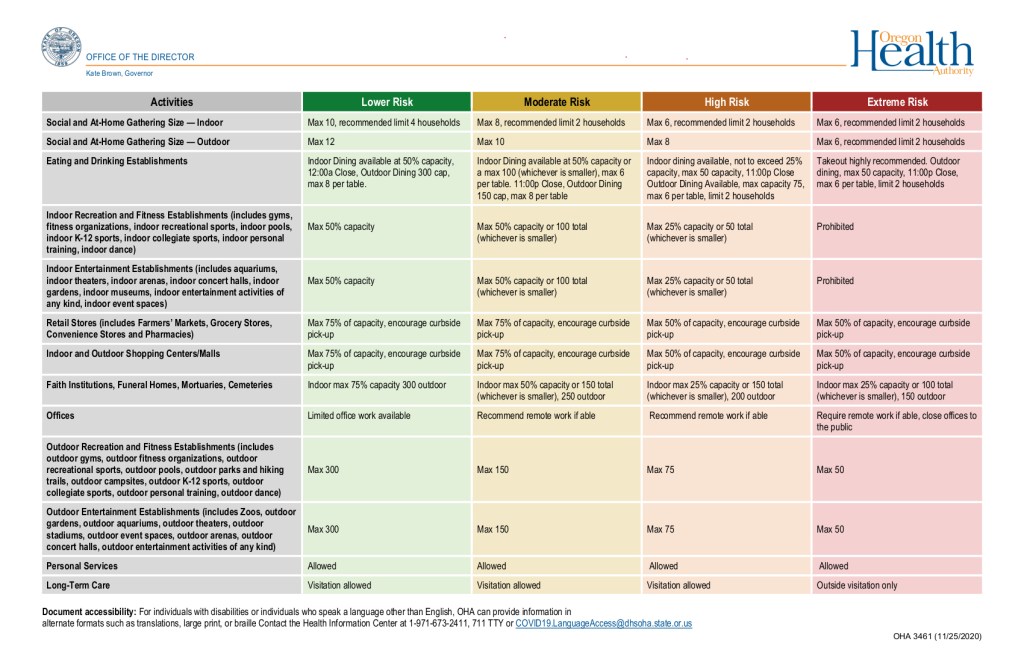Twelve counties see COVID-19 restrictions loosened Friday
Published 10:59 am Tuesday, February 9, 2021

- County risk table 12-29
Twelve counties will see fewer COVID-19 restrictions on businesses and activities beginning Friday, Feb. 12 as the state dropped risk level ratings for counties due to a decline in new infections.
Ten counties moved out of the extreme risk category, some for the first time since November. That list include Deschutes, Clatsop, Columbia, Lincoln, and Linn, which all moved from extreme risk to high risk.
Morrow County made a two-tier drop from extreme to moderate risk. Baker County also fell two spots, moving from high to lower risk. Grant County went from moderate to lower risk.
The biggest news statewide was the move of the Portland tri-county metro area of Multnomah, Clackamas and Washington counties, also going from extreme to high risk.
“This is welcome news, as we’ll start to see more businesses open up and Oregonians being able to get out a bit more,” Gov. Kate Brown said Tuesday in announcing the updated risk levels.
The announcement ends a streak of sustained extreme risk levels for most of the populous areas in the state, going back to November.
Through Monday, Oregon has reported 147,219 COVID-19 infections and 2,024 deaths. After peaking at over 1,500 cases per day over a one-week average in early December, the infection trend wobbled through the holiday season before beginning a steady drop at the beginning of 2021.
The current seven-day average is just above 584 new cases per day, according to the Oregon Health Authority.
The risk level moves means that beginning Friday, counties can loosen restrictions on indoor dining, gyms, gathering sizes and other areas. The new levels are good through Feb. 25.
New risk levels will be announced in two weeks, on Feb. 23, to go into effect Feb. 26.
The new rankings leave 14 counties in the extreme risk level, 11 at high risk, two at moderate risk, and nine at lower risk.
Among the counties still at extreme risk are Umatilla, Crook, Jefferson, and Union.
The extreme risk category includes Marion County, site of the state Capitol; Lane County, home of the University of Oregon; and Benton County, home of Oregon State University.
Lake moved up from lower to moderate risk.
County risk levels under the state’s public health framework aim to reduce transmission and protect Oregonians from COVID-19.
The framework uses four different risk levels for counties based on COVID-19 spread — extreme, high, moderate and lower risk — and assigns health and safety measures for each level.
The key measure for large counties to move from extreme risk to high risk is having under 200 new infections per 100,000 residents. Both Deschutes (195) and Multnomah (194) barely fell below the mark. Both counties hit the other metric: under 10% positive rate in new infections.
Since late December, the state has given at least one shot of COVID-19 vaccine to 425,076 people, with 141,874 of them having received the full two-shot inoculation.
Most of the vaccine early on has gone to health care workers, plus residents and staff of nursing homes. Long-term care facilities have accounted for over half of all deaths in Oregon.
In January, eligibility was expanded to about 150,000 teachers, school staff and day care workers. Brown has stayed with a controversial decision to prioritize school staff over elderly who are not in care facilities. Eligibility for the first age group, those over 80, began Monday. However, demand has vastly outstripped supply and OHA said last week it hopes to have 75 percent of all seniors fully vaccinated by May. Plans for additional priority groups are in planning stages. Vaccine supply is thin across the country.
Without a major increase in production of the Pfizer and Moderna vaccines now being used, or the introduction of new vaccines such as a one-shot Johnson & Johnson vaccine that could be available next month, vaccination for most of the 2.8 million adults in Oregon will likely stretch into autumn. There is no vaccine yet approved for anyone under 16.
Lower Risk (9)
Baker (moved from high)
Curry
Gilliam
Grant (moved from moderate)
Harney
Sherman
Tillamook
Wallowa
Wheeler
Moderate Risk (2)
Lake (moved from lower)
Morrow (moved from extreme)
High Risk (11)
Clackamas (moved from extreme)
Clatsop (moved from extreme)
Columbia (moved from extreme)
Deschutes (moved from extreme)
Douglas
Hood River (moved from extreme)
Klamath (moved from extreme)
Linn (moved from extreme)
Lincoln
Multnomah (moved from extreme)
Washington (moved from extreme)
Extreme Risk (14)
Benton
Coos
Crook
Jackson
Jefferson
Josephine
Lane
Malheur
Marion
Polk
Umatilla
Union
Wasco
Yamhill





